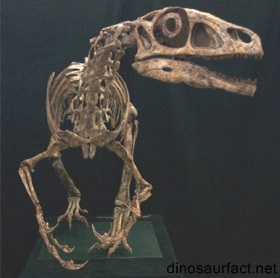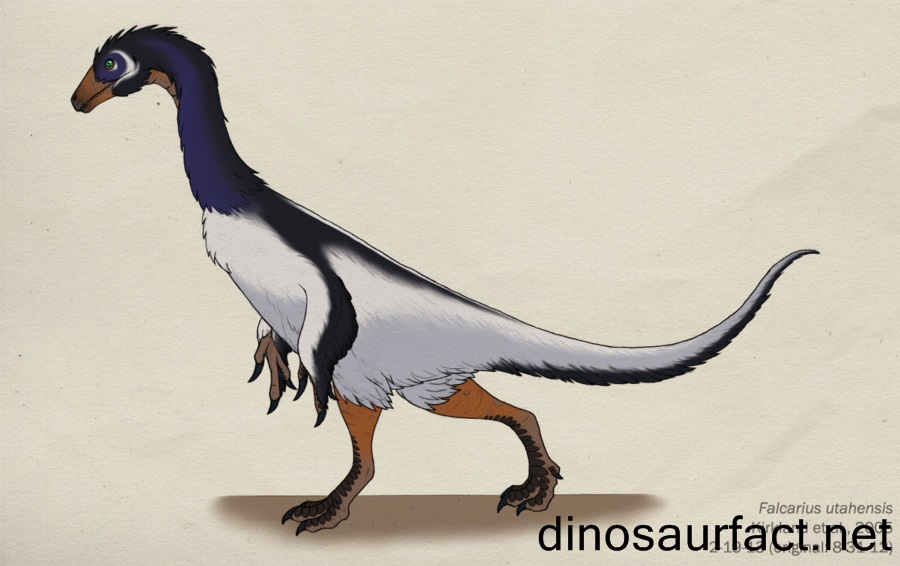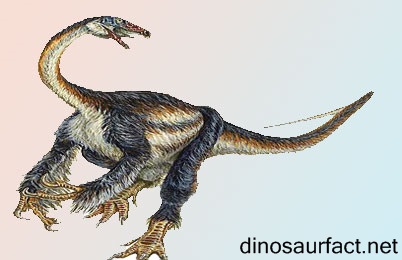 Click to visit the previous dinosaur bio
Click to visit the previous dinosaur bio
 |
|
 |
|
Kingdom: Animalia
Phylum: Chordata
SuperOrder: Dinosauria
Order: Theropoda
SubOrder: Therizinosauria
Genus: Falcarius
 |
|
 |
|
 |
|

The Falcarius was a medium sized dinosaur that walked the earth in the first half of the Cretaceous period. It was a theropod dinosaur that belonged to the therizinosaurid group. The distinguishing characteristic of the dinosaurs of this group is their elongated neck.
The Falcarius was a herbivorous reptile. This is unusual for theropods as most of them were meat eating dinosaurs. Some scientists suggest that the Falcarius could have been a transitional species showing omnivorous feeding habits, but its teeth seemed better adapted for a plant based diet.
The time period of its existence is calculated to be around 127 to 123 million years ago. This phase lies in the Barremian and Aptian ages of the Cretaceous. Its fossils have been excavated in large numbers from the state of Utah in the United States.
When the fossils of this dinosaur were first discovered in 1999, there was lot of confusion about its location in the taxonomic tree. They had shown similarities to sauropods, theropods and even certain marine elasmosaur like animals. It has been established only recently that it may have shared its ancestry with the raptor group of dinosaurs.
The size of this dinosaur was about 12 feet, and its weight was around 200 to 300 kilos.
Nomenclature
The name Falcarius is derived from the Latin word 'falcarios'. It translates to 'scythe' or 'sickle' in English. The term 'falcarius' denotes 'a sickle maker'. This name was selected for the dinosaur due on account of the sickle shaped forearms that it possessed. Such appendages had not been seen in any other dinosaur up until the discovery of the Falcarius.
The second half of the binomial name of this dinosaur, F. utahensis honors the state of Utah. The suffix 'ensis' is used in Latin names for denoting 'hailing from'. Thus, the name Falcarius utahensis translates to 'the sickle maker from Utah.'
The remains of this dinosaur were named and described by scientist James Kirkland.
Discovery of fossils
- The holotype of the Falcarius was discovered by Lawrence Walker in 1999. Walker is a professional fossil hunter and has been responsible for the discovery of many new vertebrate species. He found the Falcarius in the Crystal Geyser Quarry of Grand County in Utah.
- He brought the fossils to the attention of paleontologist James Kirkland. Kirkland then organized a search in the nearby Cedar Mountain Formation, which yielded many therizinosaurid fossils. A lot of them were attributed to the Falcarius. They were distributed over two quarries.
- The number of specimens discovered from the first quarry were about 250 in 2005. Most of them were juvenile, which could be discerned from the incomplete ossification of the skull sutures and long bones.
- The second quarry was discovered in 2008 and it was named the Suarez Quarry. Adult Falcarius specimens were excavated from here.
- By 2010, over 2000 individuals were isolated from the first quarry.
- The holotype consisted of a partial skull with almost the entire cranium intact and parts of the appendicular skeleton. The subsequent paratypes gave a good enough idea about the entire skeleton of this dinosaur.
The forelimb
One of the most distinctive feature of the Falcarius was its hand and fingers. The humerus and radius of this reptile were almost similar in size. Its carpals and metacarpals resembled those of the classic theropods. But its phalanges had very long claws. They were about 10 cms in length. For a dinosaur that was 4 meters in length, this is a substantial size. They were curved like a sickle and were quite sharp. One of the paleontologists studying this dinosaur described it as being part Edward Scissor Hands.
Considering that the Falcarius was an herbivore, these claws seemed incongruent.
Classification
The Falcarius belongs to suborder Theropoda, clade Maniraptora and clade Therizinosauria. It was a basal therizinosaurid, and had many characteristics similar to the carnivorous theropods. Scientists believe that it was a connecting link between the conventional theropods and the evolved dinosaurs belonging to the family Therizinosauridae.
When the bones of this dinosaur were first discovered, its location in the taxonomic tree was a mystery. Therizinosaurids were initially thought to be large sea turtles. Later when scientists realized they were dinosaurs, they were classified as sauropods on account of the long neck. The discovery of the Falcarius made paleontologists notice the similarities between raptors and therizinosaurids. It was after this that the entire group, including the Falcarius, was moved to suborder Theropoda.
Physical characteristics
- The Falcarius was a medium sized dinosaur. Its adult length from snout to tip of tail was about 12 to 13 feet. It was not a very heavy dinosaur and weighed about 550 to 600 pounds.
- The skull of this dinosaur is still not very well defined despite the enormous number of fossils attributed to it. Its skull was small and elongated. But the cranium was proportionately large.
- The jaws bore leaf shaped teeth. These seem more suited for a vegetarian diet as compared to an omnivorous diet. But some of the teeth at the front end of the maxillae were long and acute, indicating it may have hunted smaller reptiles.
Furthermore, the Falcarius also possessed a large pelvic cavity that most probably enclosed a long digestive system. This further points to it being an herbivore.
- The neck of the Falcarius was elongated, with its cervical vertebrae showing adaptations for the same.
- The forearms and hands of this dinosaur were characterized by the presence of three long and sharp claws. Its name alluded to their nature.
- The Falcarius had hind legs which were adapted for running. Its tibia was longer than its femur. It had four digits on its legs and only three of them touched the ground. The phalanges of the first digit did not bear weight.
- Its tail was long and slender.
- It is unknown whether the Falcarius had possessed feathers. Many of the therizinosaurids did, so scientists speculate this dinosaur did too.
Habits and habitat
The Falcarius was a bipedal, terrestrial reptile. The fossil aggregations that were found in Utah strongly suggest that it lived in herds.
The Yellow Cat member, where the Falcarius was found, had contained many rivers and lakes, along with vast plains, during the Cretaceous.
Related species
The Falcarius was related to the Beipiaosaurus. It had evolved from raptors and gave rise to the therizinosaurideans.
The final notes
Scientists have long wondered why dinosaurs like the Falcarius turned herbivorous. Some speculate it was due to the appearance of the first flowering plants in the Early Cretaceous.
Index
Extinct Profiles
 Triassic Dinosaurs
Triassic Dinosaurs Jurassic Dinosaurs
Jurassic Dinosaurs Cretaceous Dinosaurs
Cretaceous Dinosaurs Pterosaurs
Pterosaurs Marine Reptiles
Marine Reptiles Dinosaur Extinction
Dinosaur Extinction